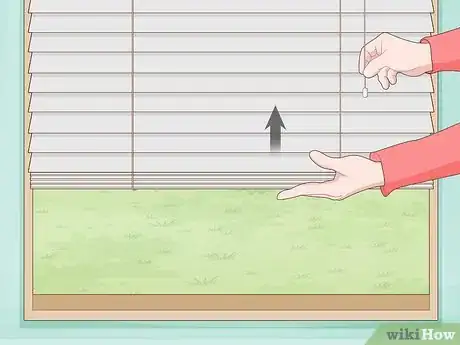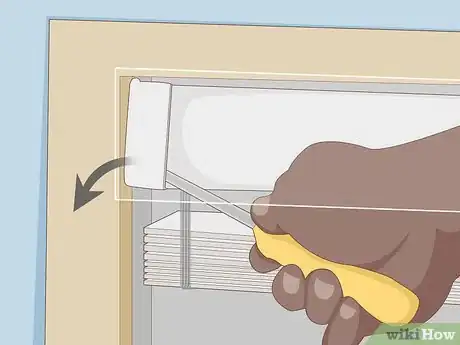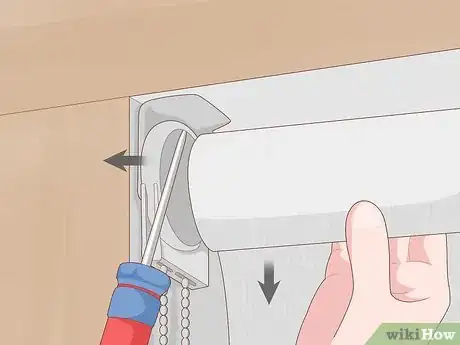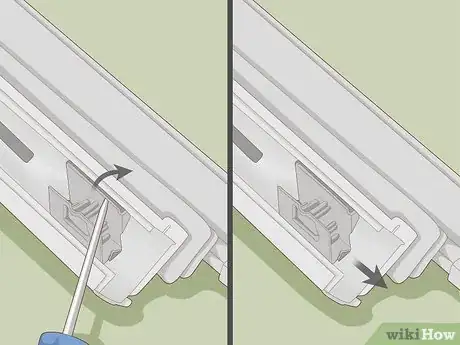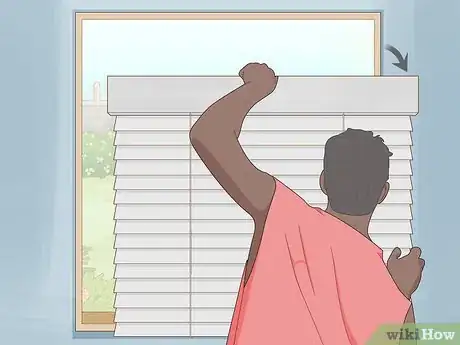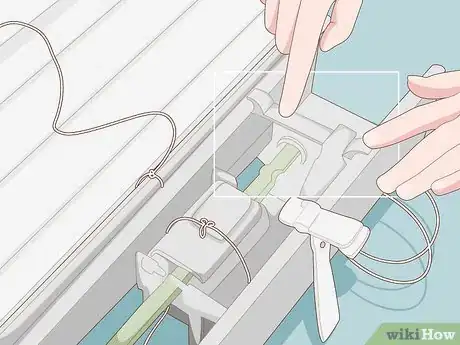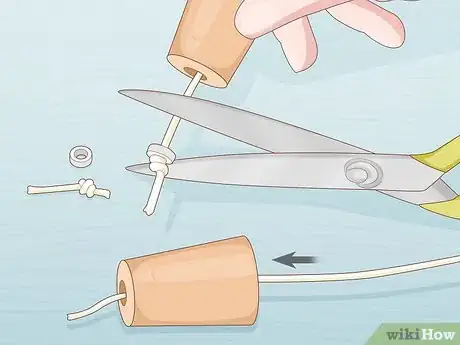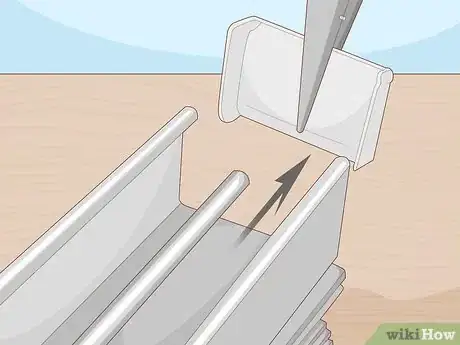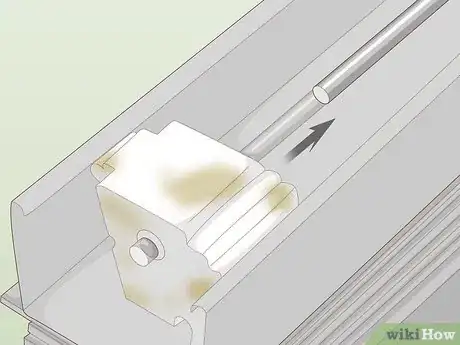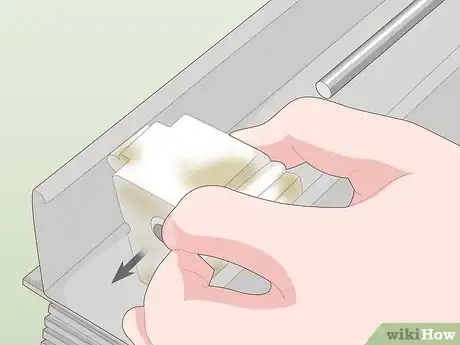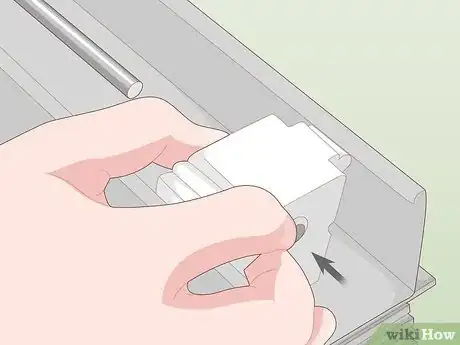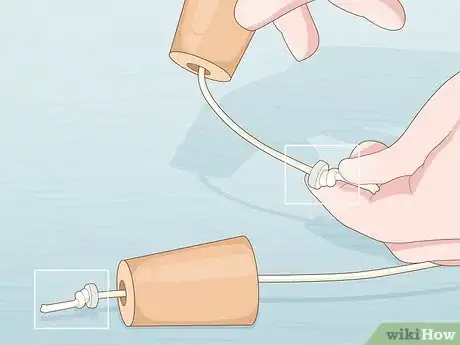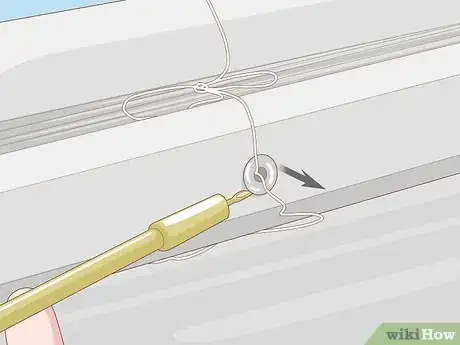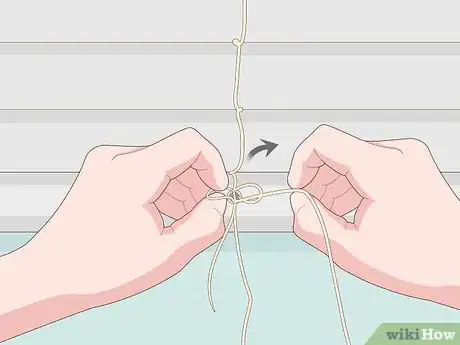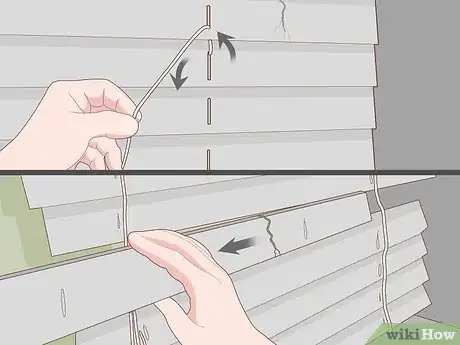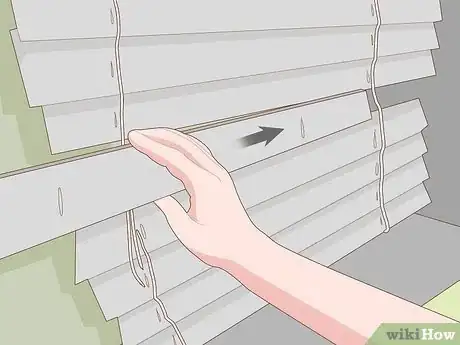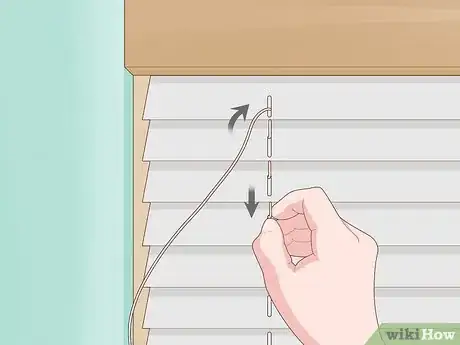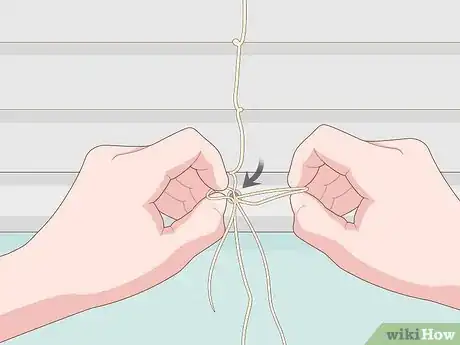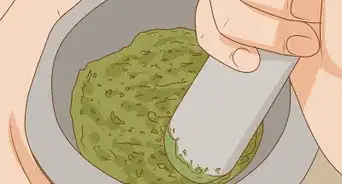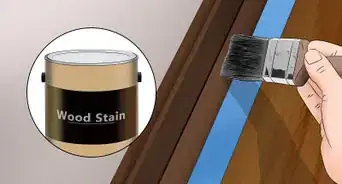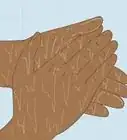This article was co-authored by wikiHow staff writer, Hunter Rising. Hunter Rising is a wikiHow Staff Writer based in Los Angeles. He has more than three years of experience writing for and working with wikiHow. Hunter holds a BFA in Entertainment Design from the University of Wisconsin - Stout and a Minor in English Writing.
There are 16 references cited in this article, which can be found at the bottom of the page.
This article has been viewed 30,781 times.
Learn more...
Venetian blinds add a classy touch to your windows, and they let you easily control how much light comes in by tilting them up or down. Over time, you may find that your blinds are stuck or damaged and need to be fixed. If you can’t open your blinds, check the cord lock to see if it’s jammed or should be replaced. If you can’t adjust the angle of your blinds, the tilt mechanism may be snagged or broken. You may also need to replace individual slats if they get damaged or broken. With a little bit of work, you’ll be able to keep your blinds in working order!
Steps
Freeing Stuck Blinds
-
1Try lifting the bottom of the blinds up to relieve weight from the locking mechanism. Grab the bottom of the blinds in the center and support the weight with your nondominant hand. Lift the blinds up toward the headrail, which is the top part of your blinds mounted to the wall. As you lift the blinds, use your dominant hand to pull the lift cords to see if they have any slack or if they control the blinds. Sometimes, alleviating some of the weight may be all it takes.[1]
- Lift the bottom of your blinds even if they are already stuck at the top near the headrail.
- If the cords still don’t pull or adjust the height of your blinds, then you may need to force the lock mechanism open.
-
2Take the headrail out of the mounting brackets. Grab the bottom of the valance, which is the decorative piece covering the headrail, and carefully pull it toward you to remove it. Pry open one of the mounting brackets on the side of your blinds and pull the headrail out of place. Carefully guide the blinds away from the window and lay them on a flat surface.[2]
- Some valances or headrails may require a screwdriver to remove completely.
- Be careful not to damage your blinds since they may hang down and bump into objects when you take them down.
Advertisement -
3Press down on the serrated roller with a screwdriver to release the blinds. Look inside the headrail near where the lift cords enter it to find the cord lock, which will have 2 metal or plastic rollers with the cords between them. Position the end of a flathead screwdriver on top of the roller that has ridges and push it down to disengage it. Once the roller is loose, your lift cords will come free so you can control your blinds.[3]
- If the roller is broken or your blinds still don’t work afterward, then you may need to replace the cord lock entirely.
- Be sure to pull each cord at the same time so your blinds stay even rather than crooked while they’re open.
Tip: Spray the cord lock with WD-40 or a similar lubricant to prevent the cords from getting caught again.
-
4Replace the cord lock if you still can’t get your blinds to work. Untie the knots at the ends of the lift cords to remove any tassels that could get in the way. Remove the end stiffener, the piece at the end of the headrail, with a pair of pliers so you can remove the cord lock. Use a screwdriver to pop the cord lock out of the tabs and slide it out the end. Push a new cord lock into place and feed the cords between the rollers and through the headrail. Reattach the tassels on the cords to finish.[4]
- You can buy cord lock mechanisms from blind specialty stores or online.
- Make sure the new cord lock system you get fits in the headrail for your blinds.
- Replacing the cord lock also fixes blinds that won’t stay open.
Checking the Tilt Mechanism
-
1Take the blinds out from their mount on the window. Pull off the valance covering the headrail and set it aside while you’re working. Pry open one of the mounting brackets on the side of the headrail with the end of a flathead screwdriver. Carefully pull the blinds away from the window and set them on a flat surface so they don’t get damaged or tangled.[5]
- Some valances and headrails may screw into the mounting brackets or into your wall.
-
2Inspect the tilt mechanism for snags if your blinds are controlled using cords. The tilt mechanism is on the same side as either the cords or wand that controls the angle of the slats, and it either has a spool or gear. If you control the tilt of the blinds with cords, then check to see if any looped cords fell off the spool and caused a snag. If it has, then pull the loop back onto the spool so the cords pull freely.[6]
- If you have a tilt mechanism controlled by a twisting wand or rod, then you need to replace the entire mechanism if it doesn’t work.
Tip: If there aren’t any snags, then there may be damage to the internal parts of the tilt mechanism and you need to replace it.
-
3Remove the cord tassels or twist wand from the tilt mechanism. If you control the tilt with cords, undo the knots at the end of the cords so the tassels easily slide off. If there’s a twist wand instead, lift it up and unhook it from place since it won’t fit through your headrail when you remove the mechanism.[7]
- You only need to remove the wand or tassels if you need to replace the entire tilt mechanism.
-
4Detach the end stiffener from the headrail on your blinds. The end stiffener is the piece at the end of the headrail so the components and mechanisms don’t slide out. Grip the end stiffener with a pair of pliers and gently pry it off the end of the headrail.[8]
-
5Slide the tilt rod out from the tilt mechanism. The tilt rod is the metal bar that runs through the entire length of the headrail and rotates your blinds. Slowly pull the tilt rod out from the end of the tilt mechanism so it’s completely free. You may need to remove the end stiffener on the other side of the headrail if you aren’t able to move the rod far enough.[9]
- Don’t remove the tilt rod from the headrail entirely since it may be hard to put back in.
-
6Pull the tilt mechanism out of the headrail. Pry the top of the headrail slightly wider than the tilt mechanism so the tabs on the sides release from place. Once the tabs are undone, slowly pull the tilt mechanism straight up so the end comes out the hole in the bottom of the headrail.[10]
- You may need to undo a screw to pull out the tilt mechanism if it doesn’t come out once you undo the tabs.
-
7Put a new tilt mechanism onto the headrail. Be sure to get a tilt mechanism that fits your headrail and matches the style your blinds use. Slide the new tilt mechanism into the headrail from the side and position it over the hole for the cords or wand. Clip the tabs onto the headrail so the tilt mechanism doesn’t move or shift around. Push the tilt rod back into the side of the tilt mechanism so it works with your blinds again.[11]
- You can buy tilt mechanisms for your blinds online.
-
8Secure the tassels or wand back onto the mechanism. If you have a corded tilt mechanism, slide the tassels onto the ends of the cords and tie knots so the tassels can’t fall off again. If you have a twist wand, place the loop on top of the wand over the hook on the tilt mechanism to secure it in place. Try pulling the cords or rotating the wand to see if the new twist mechanism works.[12]
Replacing Damaged Slats
-
1Remove the caps on the bottom of the blinds with a flathead screwdriver. Make sure your blinds are fully extended and horizontal when you begin. Find the 2-3 caps on the bottom rail of your blinds that hold the cords in place. Use the end of a flathead screwdriver to pry the caps off of the rail so you can see the knots inside.[13]
- The number of caps depends on the width of your blinds. If they’re wider, then you may have more than 3 caps, and you need to remove all of them.
- You can either keep your blinds on the window or take them down while you work.
-
2Undo the knots holding the cords in place. Pull the cords out of the bottom rail so you can access the knots. Pull the knots apart with your fingers so the cords are straight and can easily travel through the holes in the blind slats.[14]
- If you can’t undo the knot yourself, use a screwdriver to help pry apart the cords.
Warning: You won’t be able to open your blinds once you undo the knots on the bottom rail.
-
3Pull the lift cords through the blinds so you can remove the slats. Locate one of the slats that you want to replace and grab the cord going through the middle of it. Pull the cord up through the slat you want to remove and all the others underneath it. Remove each of the cords running through the slat before slide it out of place. Repeat the process for any other slats you need to replace.[15]
- The slats underneath the one you’re removing will also be loose once you remove the lift cords, so be careful so you don’t accidentally knock them out of place.
-
4Put new slats into the slots where you removed the damaged ones. Get slats that are the same style as your existing ones so your blinds don’t clash when you’re finished. Find the slot where you pulled the old slat from and slide the new one into place. Make sure the holes in the middle line up with the lift cords. Repeat the process for any other slats you replaced.[16]
- You can buy blind slats online or from home improvement stores.
-
5Feed the cords through the holes in the slats until you’ve reached the bottom. Once you have all the new slats in place, guide the ends of the cords through the holes in the middle of the slats. Make sure you slide the cords through all of the slats, or else they won’t lift up when you pull on the cords to open them.[17]
-
6Tie knots in the cords before replacing the caps. Tie an overhand knot on each cord before pushing it back inside the bottom rail of your blinds. Make sure the knot is tight so it doesn’t come undone as you use the blinds. Push the caps into the holes until they snap back into place.[18]
- Don’t tie the knot so large that you can’t fit it back in the bottom rail of your blinds.
Warnings
- Don’t try to force the cords on your blinds if they won’t move since you could pull the blinds out of their brackets and damage them.⧼thumbs_response⧽
Things You’ll Need
Freeing Stuck Blinds
- Flathead screwdriver
- Cord locking unit
Checking the Tilt Mechanism
- Pliers
- Tilt mechanism
Replacing Broken Slats
- Flathead screwdriver
- Replacement slats
References
- ↑ http://shared.springswindowfashions.com/SwfShared/pdf/troubleshooting/TS_2H-CordLockRelease_7.18.11.pdf
- ↑ http://shared.springswindowfashions.com/SwfShared/pdf/troubleshooting/TS_2H-CordLockRelease_7.18.11.pdf
- ↑ http://shared.springswindowfashions.com/SwfShared/pdf/troubleshooting/TS_2H-CordLockRelease_7.18.11.pdf
- ↑ https://youtu.be/W8K0nJGZ0ao?t=26
- ↑ https://youtu.be/SgYKHPfUL_0?t=51
- ↑ https://youtu.be/SgYKHPfUL_0?t=71
- ↑ https://youtu.be/L843cqb3We4?t=26
- ↑ https://youtu.be/L843cqb3We4?t=44
- ↑ https://youtu.be/L843cqb3We4?t=50
- ↑ https://youtu.be/L843cqb3We4?t=60
- ↑ https://youtu.be/L843cqb3We4?t=111
- ↑ https://youtu.be/L843cqb3We4?t=160
- ↑ https://youtu.be/ZlKdtMEYTo8?t=23
- ↑ https://youtu.be/ZlKdtMEYTo8?t=30
- ↑ https://youtu.be/XSLn7v9cCKg?t=285
- ↑ https://youtu.be/ZlKdtMEYTo8?t=65
- ↑ https://youtu.be/ZlKdtMEYTo8?t=88
- ↑ https://youtu.be/XSLn7v9cCKg?t=544
